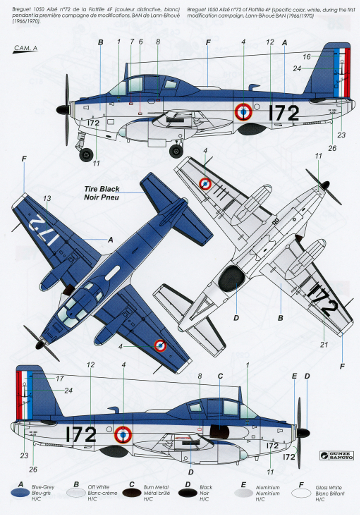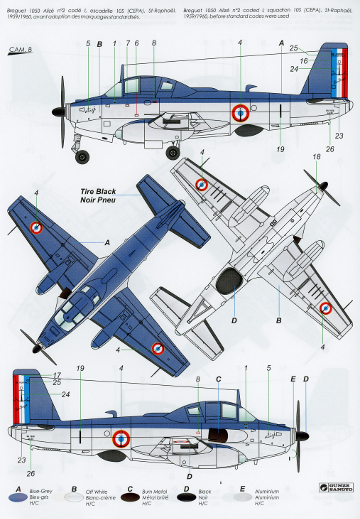FR0028 Breguet 1050 Alizé 1G France -sold out
History:
The Breguet 1050 Alizé carrier-based Anti-Submarine Warfare (ASW) aircraft was derived from the Breguet 960 Vultur, an unsuccessful attack aircraft design that was limited to only three prototypes. The Alizé prototype first flew on October 5, 1956. This was followed by a trials period that included catapult and landing tests at the Royal Aircraft Establishment in Bedford, England. Three prototypes and two pre-production machines were built, with the first delivery of a production machine to the French Navy being made on November 15, 1957.

The Alizé replaced the Grumman Avengers in the submarine hunter-killer role, with 6 Flotille (6F) being the first squadron to receive the Alizé in 1959. 6F served as an operational training squadron, familiarizing both flight crews and support personnel with the new aircraft.
Alizés served with 4F, 6F, and 9F, as well as various ancillary units including 2S, 3S, 10S, ERC, EPV and 59S. Embarked aboard the carriers Arromanches, Clemenceau and Foch, Alizés participated in many exercises like Atlantis 69 and Alligator III, and on operations including Saphir in the Gulf of Aden, Olifan over Lebanon, Prometheus and Salamandre in the Gulf of Oman, Balbuzard in the Adriatic Sea, and Trident over the former Yugoslavia.
The Alizé underwent its first upgrade between 1966 and 1970 with no change in model designation, although some aircraft serial numbers were temporarily re-assigned in the 100 series, meaning for example that aircraft 45 temporarily became 145. Later, between 1978 and 1983, thirty Alizés were modified to a standard designated as ALizé Modifié (ALM). Between 1996 and 1997, fifteen Alizé ALM’s were further modified to ALizé mis à Hauteur standard (ALH). Following this, any unmodified airframes were identified as Alizé 1st Generation, to distinguish them from those with later upgrades.
At end of its service life, the Alizé was used for coastal and sea surveillance. The last Alizés (ALH) retired from service with 6F in 2000, although a few remained to be seen on some French bases after this date. Alizé number 59 was returned to flight status and given the civil registration of F-AZYI.
India bought fourteen Alizés for service aboard the carrier INS Vikrant. Alizés fought in the Indo-Pakistan conflicts of 1965 and 1971, when they were involved in the hunt and destruction of one Pakistani submarine, but also lost an Alizé (serial number IN203). Indian Alizés were all 1st Generation airframes, and served from 1960 to 1991. Attempts to export the Alizé to Brazil, the Netherlands, Peru, Israel and Indonesia were pursued but did not lead to sales.
Specifications (1G): ASW carrier-based monoplane, three-crew members (pilot, navigator, radar operator). Engine: Rolls-Royce Dart 21 turboprop , delivering 1950 cv. Wingspan 15.60 m, length 13.86 m, wing area 36 m2. Economic cruising speed at 182 knots (336 km/h), normal endurance 4 hours, range 2500 km. Usual weapons: 6 ASM rockets under the wings, three 160 kg depth-charges in the bomb-bay. Other possible combinations include 700kg torpedo in the bomb-bay, bombs, SERAM rockets, and wire-guided missiles.
Documentation :
- Breguet 1050 Alizé, Arnaud Prudhomme, Histoire et Collections (in french, 68 pages
- Antennas on tip of wings have been forgotten (please see box art)
- Breguet 1050 Alizé n°72 of Flottille 4F during the first modification campaign, Lann-Bihoué BAN (1966/1970)
- Breguet 1050 Alizé n°16 of Flottille 9F, group ALFA 1966 aboard Foch carrier, French Polynesia, May to September 1966
- Breguet 1050 Alizé n°2 coded I, squadron 10S (CEPA), St-Raphaël, 1959/1960


